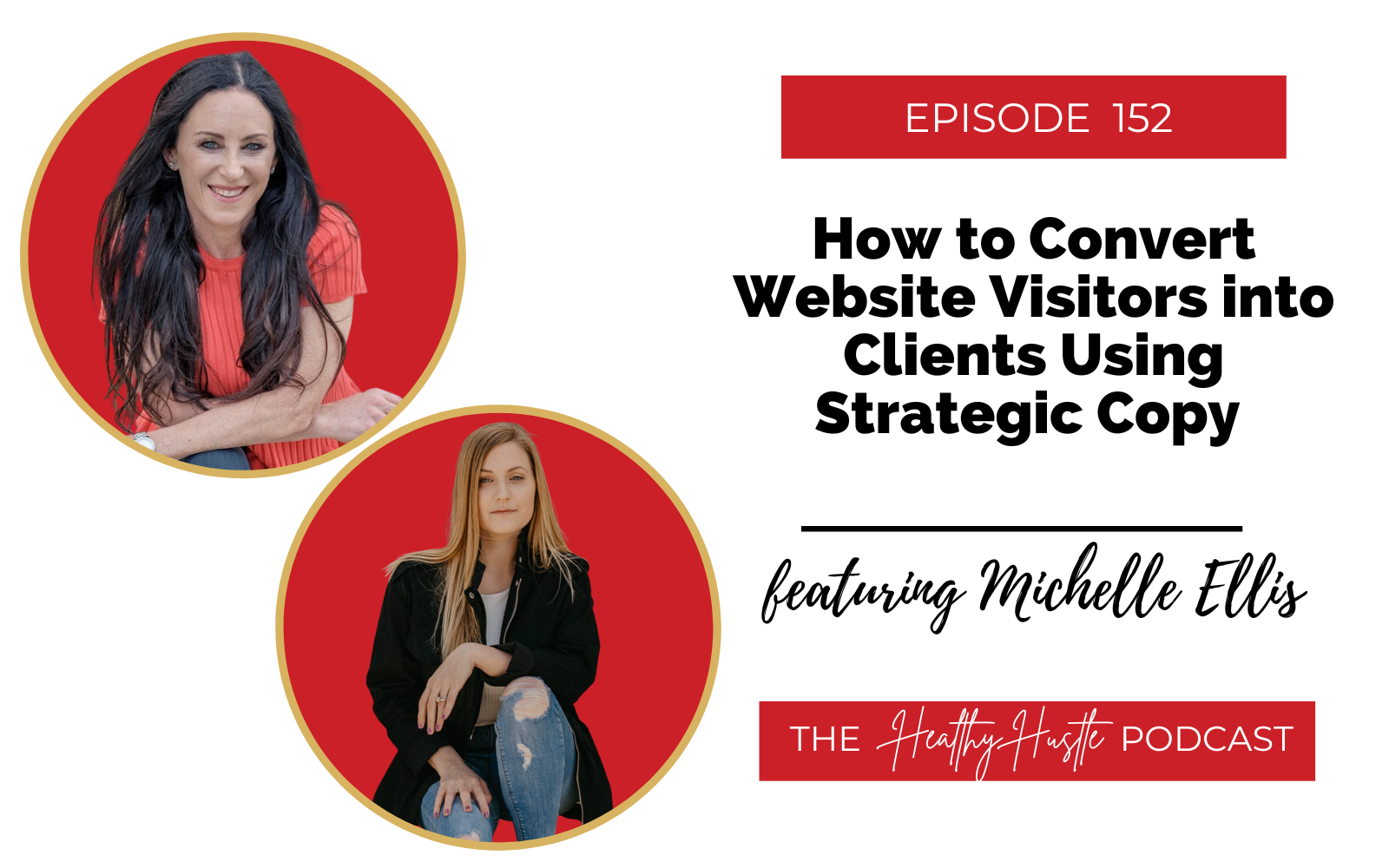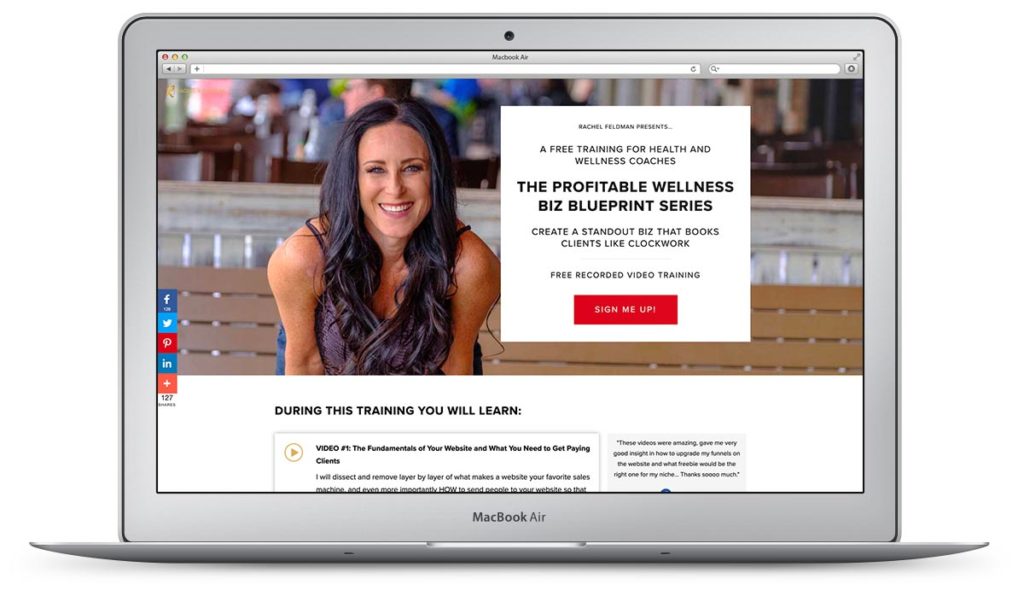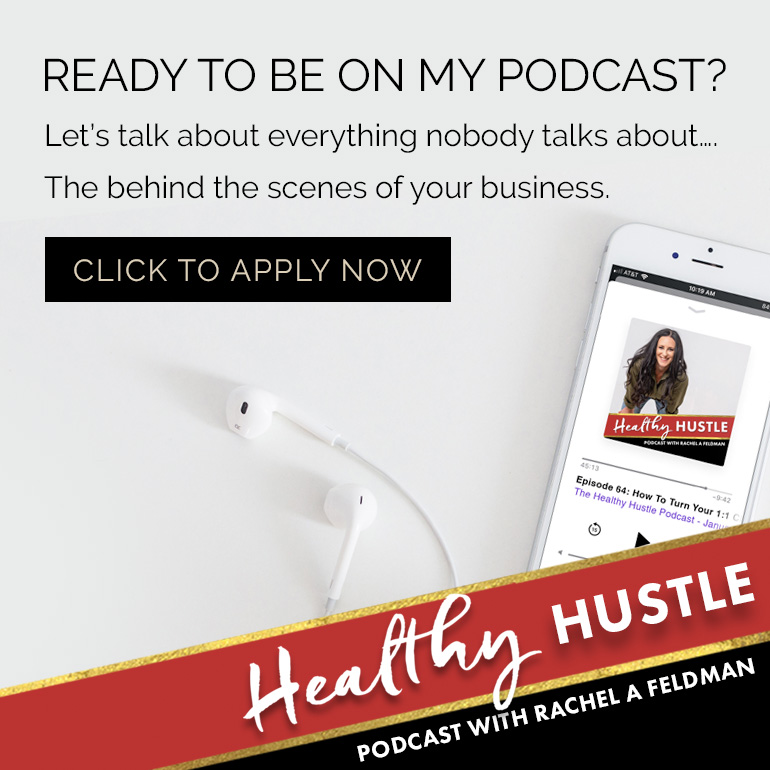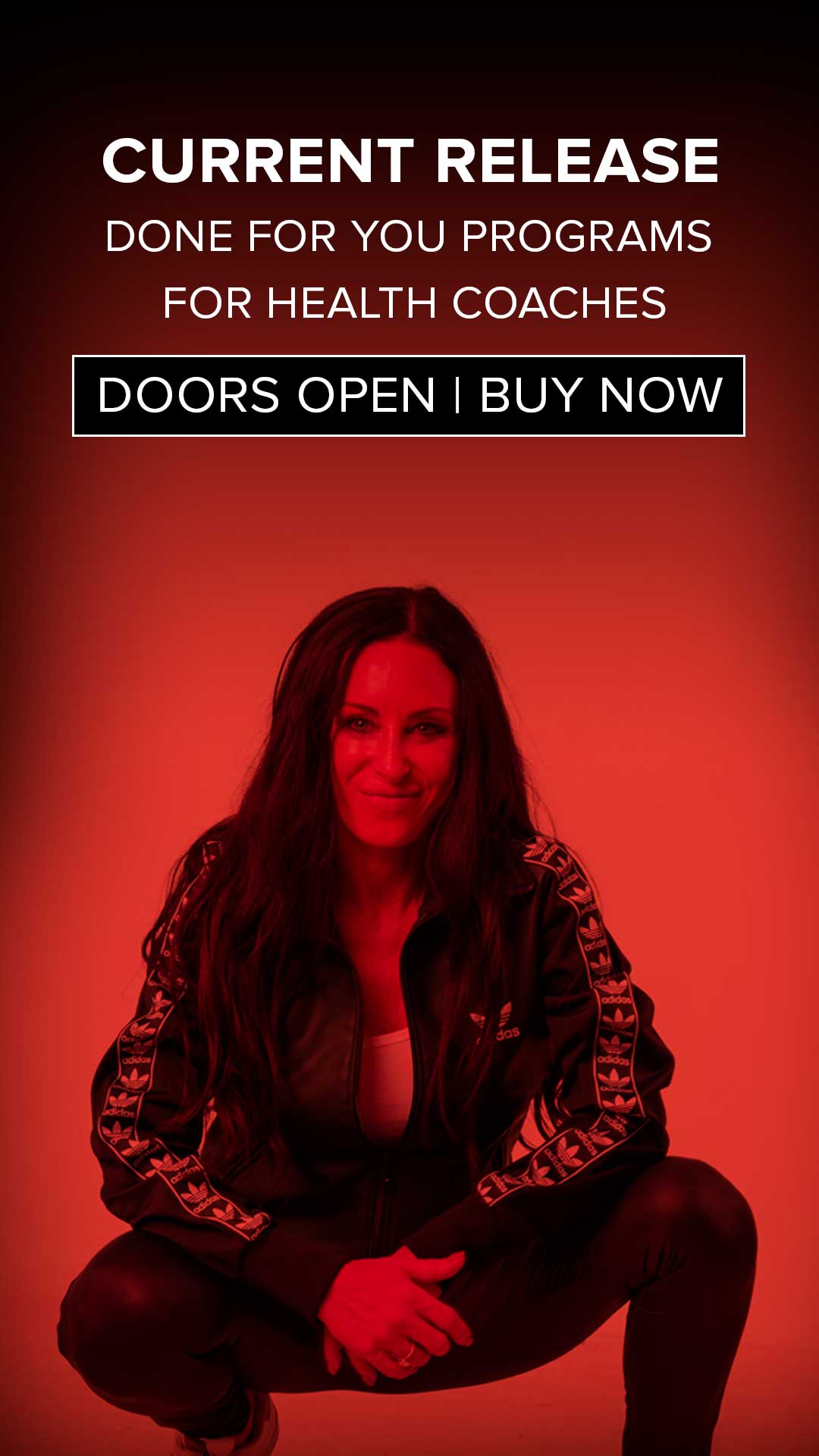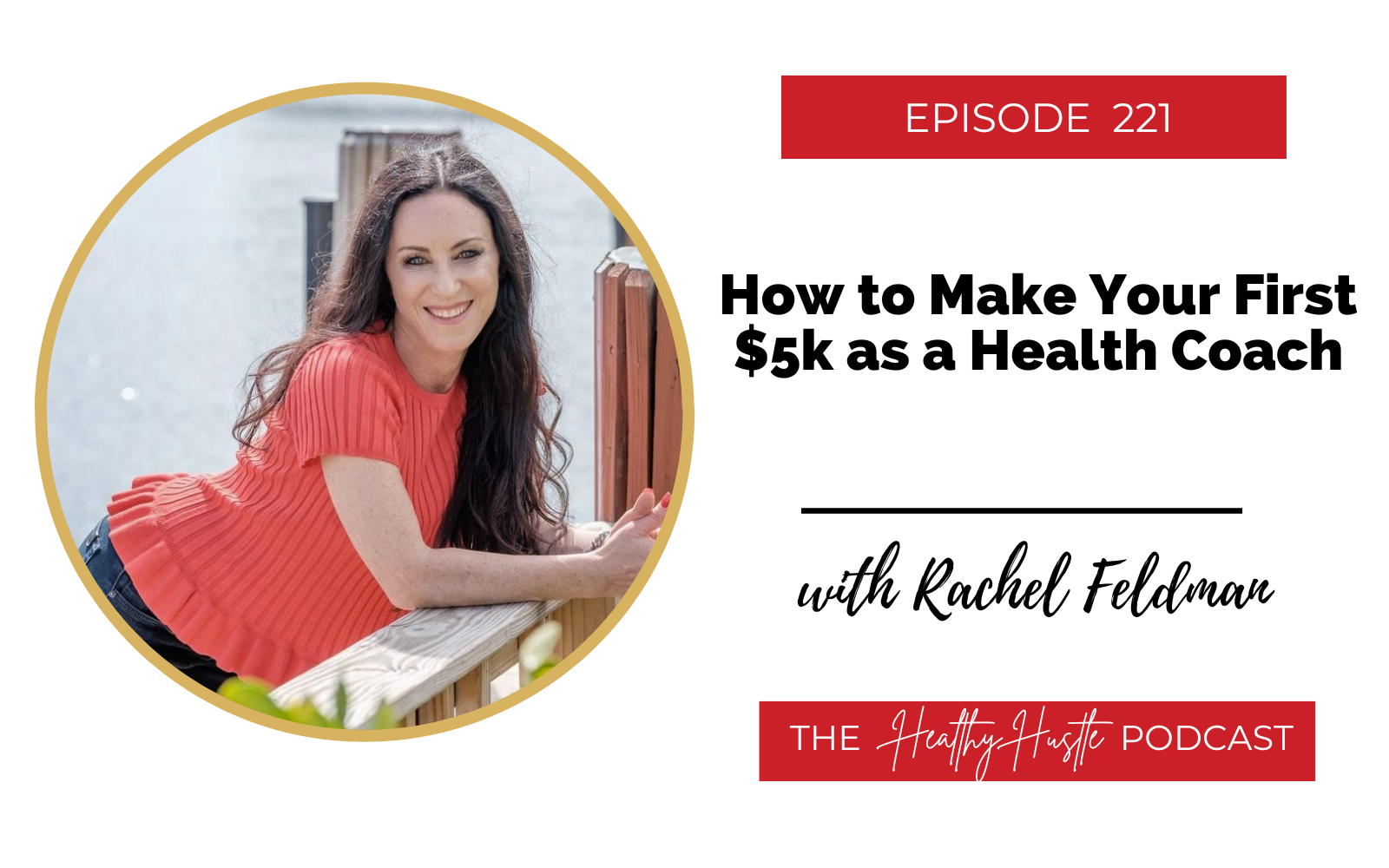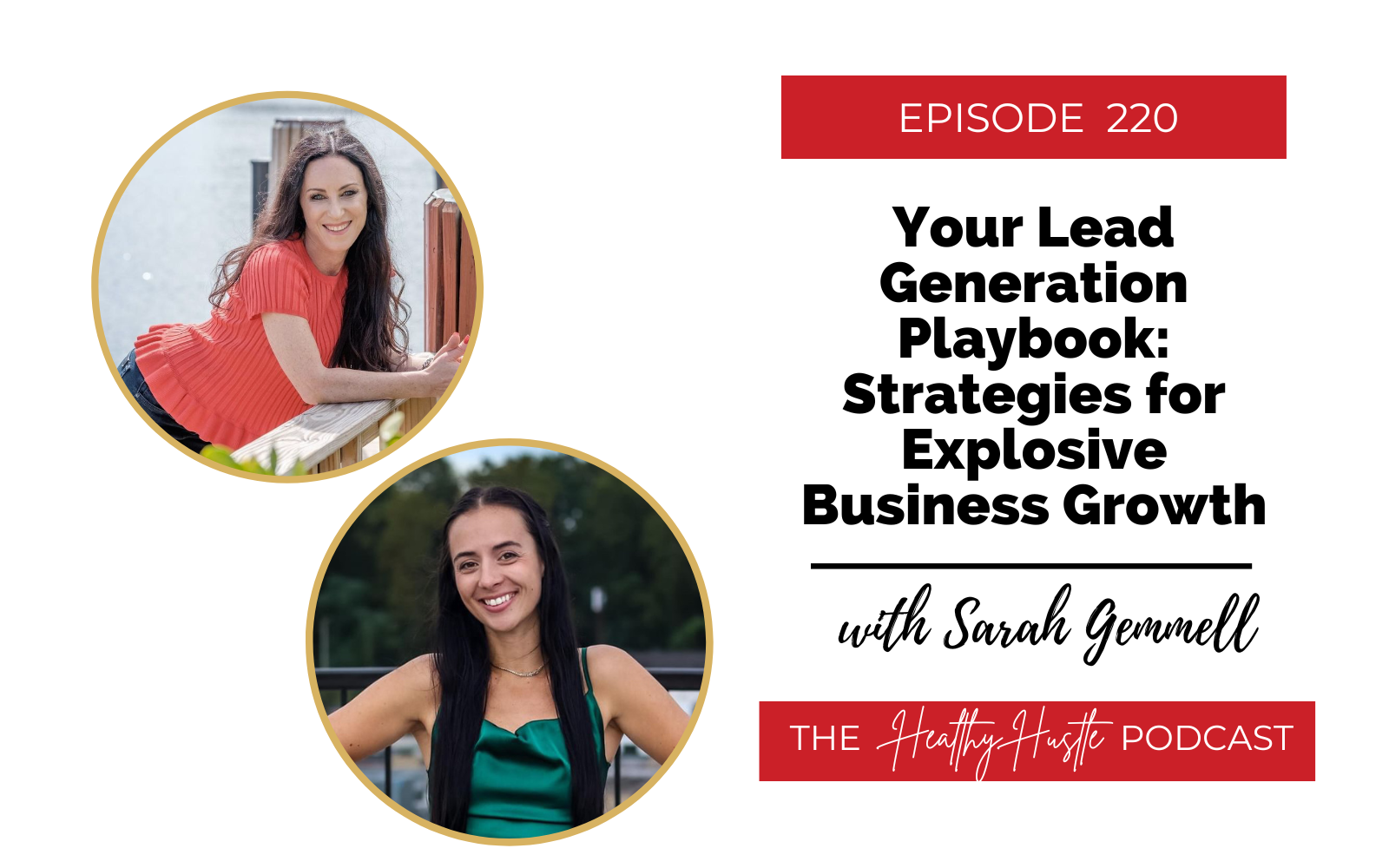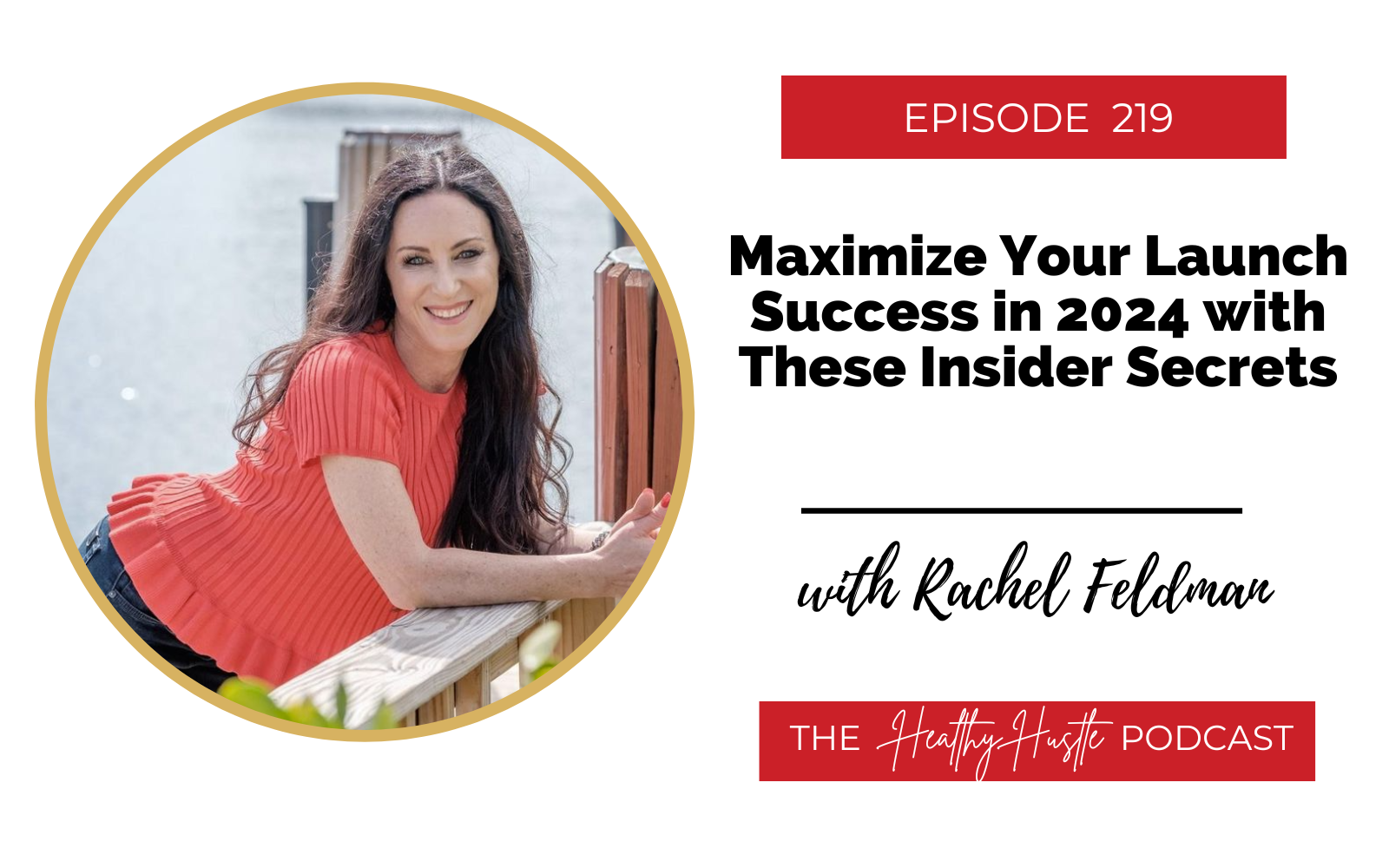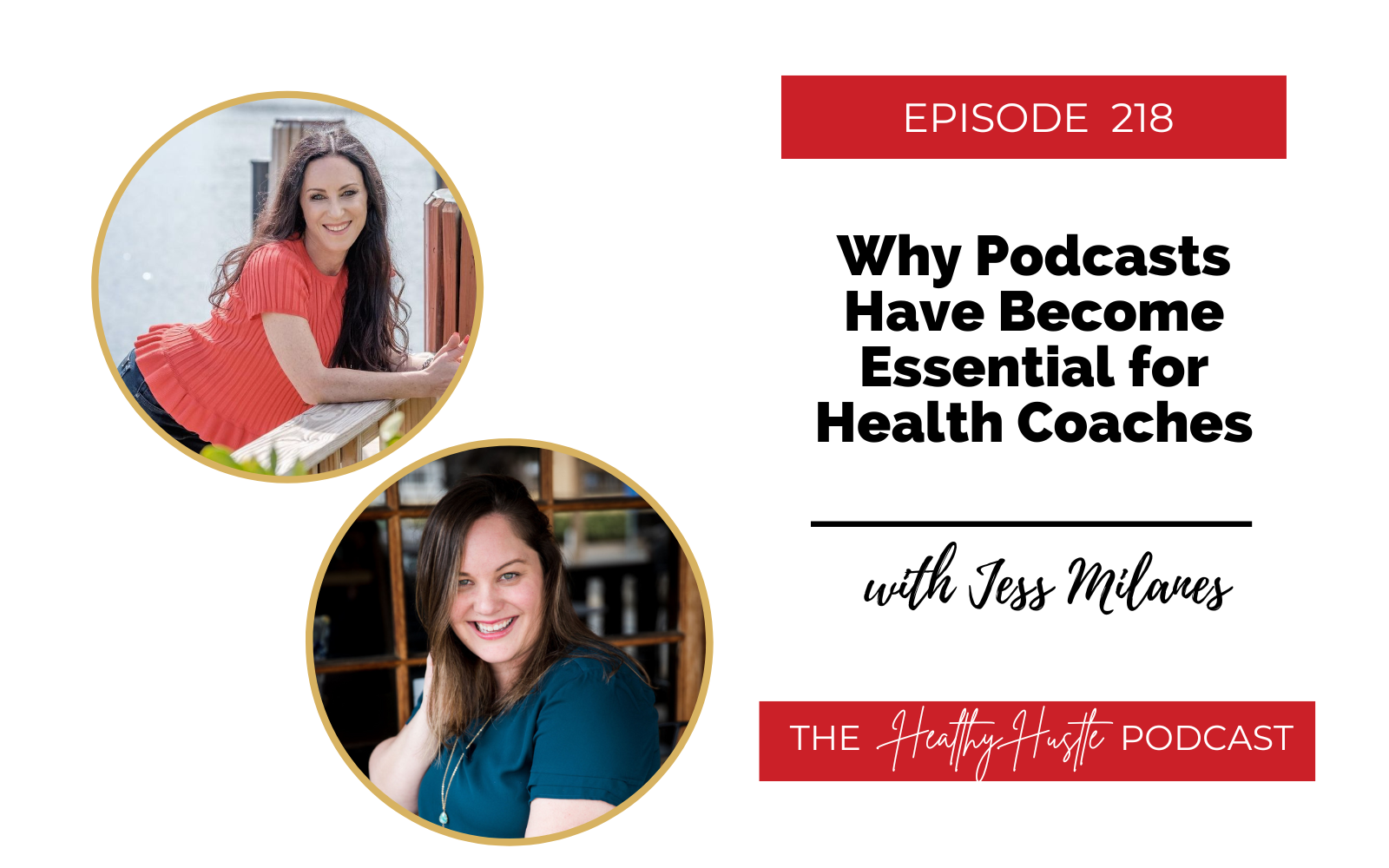Is your website converting lurkers into paying clients? Or is your sub-par website letting down your client roster? Honestly, if your website “looks good,” but it’s not converting, it’s probably your copy.
Why? Because if your people don’t know who you are, if they can’t connect with you through your words, if they don’t know what solution you can provide them and how you can provide it – then they won’t be convinced to work with you! And we don’t want that.
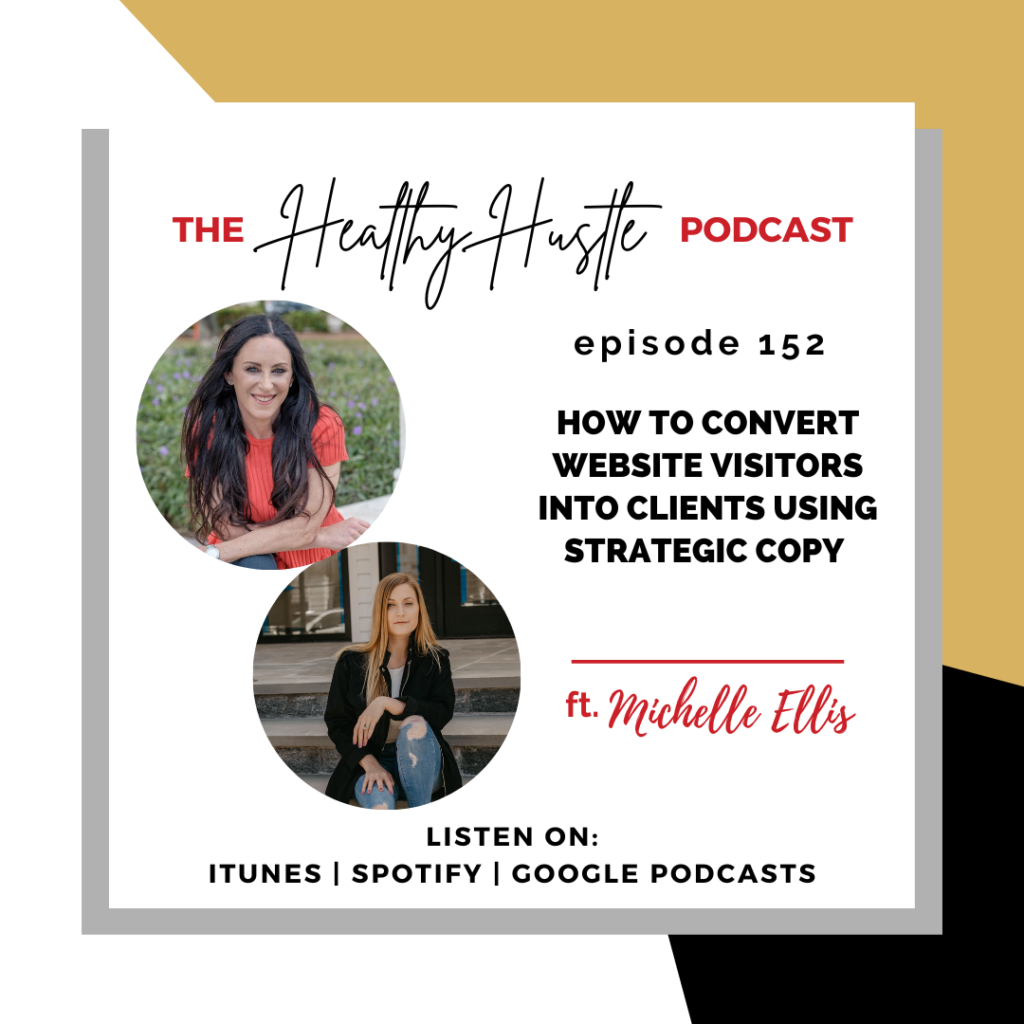
In this episode, copywriter Michelle Ellis walks us through exactly what you need to write on your Home Page, About Me Page, and Work With Me Page so you can convert visitors into paying clients!
Connect with Michelle:
Michelle’s website: https://michelleellisco.showit.site/#/
Michelle’s Instagram: https://www.instagram.com/theorganiccopywriter/
Rachel: I am super pumped for this because Michelle Ellis, an amazing copywriter is back on the show. Michelle also graduated from the same school that I attended, which is the Institute for Integrative Nutrition.
I know that there are a lot of coaches out there who are in different phases of their business. But if you have a website that is not converting, this episode is definitely for you.
You may also be in that process where you’re updating your website content, maybe you haven’t gone through it in a few years, and you know it needs an upgrade. Or maybe you’re at the beginning phases, and you’ve just graduated from school, you’re super excited, you’re super pumped, and you’re like, let me have my copy actually speak to my ideal client.
Because we don’t want you to make the mistake that so many coaches make, which is having the copy on their website not speaking to the heartstrings of their ideal client, making it really impossible to convert. Remember, you have just a few seconds to grab your ideal client’s attention.
Elements Of A Home Page That Every Health Coach Needs
Let’s talk about copywriting. I see so many homepages that either have nothing or they are extremely long. And I don’t see some of those questions at the top that you and I talk about all the time, which are so essential to have on our homepage. Let’s talk about the elements of a homepage that every coach needs to have.
Michelle: One thing that you need to do before they even approach or revisit the homepage, is to know your ideal client and who the homepage is for. That will help you determine which questions to ask and who to talk to.
I often see this discombobulated crazy messaging, or it’s super general and it’s speaking to everyone. So the idea of having the homepage is number one, that’s the most visited page on any website. It’s the first page that everybody goes to.
So once you know who your ideal client is, you know who you’re talking to, you always want to have an open-ended question. It’s your hook question. In the beginning of a lot of times if you’re building your own website, they call it the hero section. So it’s usually the header, which is right under the menu bar.
And it’s usually some type of picture, and typically, either on the left or the right of the picture is an open-ended question. A little line tagline and a call to action button right there, which is what in the marketing world, everybody calls above the fold. It’s above that first line. Typically, what that means is if you’re viewing it on your mobile device, it’s the one thing you see before you have to scroll.
We’re talking about the top of your website, that banner. So you need to know your offer, you need to know the problem, to be able to ask whatever question that relates to what they’re dealing with.
And then it’s best to provide a really clear solution in a downloadable or even accessible form. If it’s free training or anything like that, have them download it. Gone are the days where you say, sign up for my newsletter, sign up for a discovery call. It’s like whoa, date me first, before we get into marriage.
Rachel: Even that right away can be pretty weird. If you have something that in the health coach world that could be a bundle of recipes that are related to your niche that could be, if you’re a gut coach, could have the seven-day gut reset right there giving them instant access. Be simple but give them a solution right away to their gut problems. Get them on a healthy track.
Michelle: Exactly. So then from there you can figure okay, they see all that, they know right off that interest is this sense of authority and proof. And this person gets me, they’re experienced and they know what they’re talking about, they have something for me to make sure that it’ll help my problem.
Then they scroll down. And usually, you can go a couple of ways here, you could have a testimonial right underneath that, you could have a short picture of you on the left and a short little paragraph of your about me page, and then they can click to learn more. Right underneath that, you could even take it one step further and ask further deeper questions.
Rachel: My favorite is when you’re just bringing somebody right into step into your symptoms and your problems. You identify with this. And so you want to keep reading, or you want to start clicking on my site to my About Me page, to my work with me page, to my program page.
Where & When To Link Other Website Pages From Your Home Page
Michelle: Exactly. And then right after that, when you’ve hit the pain, you’ve injured yourself a little bit, you have the solution on the homepage, you can take a soft approach to that. It also depends if you’re an avid blogger because then you might want to feature your blogs on the homepage if that’s your traffic driver. If you like to blog frequently, like a couple of times a week, and you’re actually driving people to your blog, have that there. If you’re not really doing that, don’t shove blogs.
Rachel: Can they put a free training right in the middle?
Michelle: You definitely could and it doesn’t even have to be the same as the original offer. So it could be something different. What I love to do is three ways to work with you or something like that. That leads them over to your work with me page. So you’re basically using the homepage as a way to 1) connect with your ideal audience, 2) offer a solution and 3) have different ways for them to veer off and discover more on your website.
Rachel: That’s a link to your about page through teasing it out a little bit where it’s a link to your work with me page and teasing that out?
Michelle: Well, I often will say three quarters down a page is that picture and a little bio, and it will say learn more and links to the About Me page. And right under that, you could have three ways to work with me.
Rachel: Absolutely. Now, what I use for my own site has it embedded into every single page on the rest of the w pages on the website. So even on the about page, it just leaks over into the other ones.
Michelle: So it’s hardwired into the frame of the website. And what’s nice about that is that typically it doesn’t have to be. For example, the box to the left can be either a low offer or it can even be something for free, maybe that’s a free training, and that leads to a series of emails.
The middle could be your low or mid-ticket type of offer. And then to the right, just because that higher ticket price is not something you ever want on a page to display. However, if it’s over two grand, lead them to a call, you can still have a brief paragraph of what the offer is and everything, but send them to book a call with you to discuss or apply to discuss what that actually looks like.
So this way, your homepage is that solid foundation of the layout of your internet house and it really features all the ways to work with you.
Rachel: Yeah, bringing people to different opt-in freebies. And at the bottom, you could also do your Instagram feed.
Michelle: Absolutely, yeah, well, so have another freebie at the bottom if you want as well or repeat one of the freebies that you had at the top of the fold. What’s really nice about that is you’re the reason why that hybrid style page is so nice is because it’s releasing the expectation that they’re actually going to go and click off like go scroll back up and hit the menu bar, and then go to another page. They may not. Especially if it’s cold traffic they might just be quickly browsing. What do you do? How can you help me? That’s why you have to hit it hard on the homepage, really asking those open-ended questions of, do you struggle with this, this and this? Tie it all together with your niche and know their pain and know their struggles.
Rachel: I would say to definitely get to those pain and struggles and do discovery calls. You can take the exact verbiage that this person says about their problems and put that right on your homepage. It’s using their verbiage of the problem instead of having that health language.
How To Use The Right Verbiage & Tone Depending On Your Business
Michelle: Exactly. And that’s another thing too, really trying to be down to earth and showcase your personality, your tone of voice. Allow that to just seep into the page. And throughout the whole website.
The only time that it should ever appear corporate style or super business is if that’s your lane, if you’re a corporate wellness coach, then you want to speak in the third person, you want to have the professional bio, you want to have that type of corporateness on your homepage.
Whereas when you’re coaching just the everyday person who’s not a career professional or business, and you’re coaching a busy mom, or anyone else, they just want to feel
like they’re talking to their friend or use the girl next door kind of verbiage.
And not any of this super black and white, just very matter of fact verbiage. Don’t make the mistake where you speak in first person and third person.
Rachel: Yes. And it’s crazy. Do you struggle with this? Do you struggle with this? Do you struggle with this? And then, I can help you. And then it would be but Michelle is X-Y-Z, and it’s like well, what just happened there?
Michelle: Yeah, I think it’s a fear of when it comes time to talk about yourself, it’s not as easy to say I’m actually an expert in this, I actually went to school for this, and I know what I’m talking about. So that’s why some people switch it as if they’re talking about someone else.
Old sales letters used to come in the actual mail and if you’ve ever opened up mail 15 years ago, it was like 10 pages stapled together in an envelope, and it was a sales letter. It’s the same type of sales letter flow that people use, actually today, for sales pages. And it was an actual letter signed by the person at the bottom. And that’s how the whole website should really flow. As if it’s really us speaking to this person. What do you want to help them with and looking at every section. If they only saw the top part of your website, what do you want to tell them? If they don’t click anywhere else? That’s the most important part of your website.
The Essential Pages Of A Website
Rachel: So let’s talk about the essential pages of a website.I love to order them because I always I see the homepage, and then I see recipes, and then I see about me or blogs and contact me.
Michelle: Yeah. You can even do a sub-menu underneath of those. If you have a lot of content, or you have a handful of programs or something, underneath your work with me, you can categorize that in little drop down menus as a health coach. Maybe it’s your 14 day programs, 30 day programs. This way, there’s just some organization there and it’s not this big bombardment of call to action, because that’s what each of those clickable links are.
So what we want to do is make sure that we’re streamlining it so that we’re taking out the decision-making process. This is what it is and don’t overstuff the menu bar thinking that you have to. I have seen ones where the individual recipes were in the menu bar and there was so much clicking.
Rachel: I went to somebody’s website the other day, and the drop-down for programs went 14 drop down deep. And I was like, Okay, maybe this is when it’s great to have some of the self-paced as do it yourself, maybe it’s a chop down. So actually see which ones were masterminds, which were pace yourself programs, Which ones were groups.
Michelle: Exactly, and categorizing them into those three bucket areas if you have self-paced courses and things that digital products they can check out without even talking to you. That could just be a shop page should be a shop page.
Rachel: You’re exactly right.
Michelle: And that would be a lot easier. The ones that require the programs that require coaching level from you should really have a full sales page
When A Work With Me Page Becomes A Sales Page
Rachel: Let’s talk about work with me before we get to about me, because we’re kind of in that theme right now. If somebody has a work with me page and they are doing group coaching only, does that Work With Me Page become the sales page for that group coaching?
Michelle: As long as it’s within one program. If you have multiple program options, you’ll want different sales pages for each focus. But let’s say you’re doing one specific group coaching program, it would be great to have a sales page for that, and you really want to include on that work with me page. Obviously, again, the pain you want to get into like that.
So really, in essence, it’s who it’s for, and you don’t have to say that typical language of who this is for, or this is for you, if you can really play around with that. If you’re struggling with XYZ then stick with me and keep reading. Just make it that conversational tone, how the process works, what’s included is really going to be a question, especially on sales pages, especially when people are buying programs. What do they get? Not just the benefits. Always cover the benefits, but they also want to see what they get in the sense of –especially in the health coaching world, when you’re delivering meal plans and suggested meals and recipes and things that are of high value, they should see that, and they should also have values alongside them. What is it really worth? Things like that total value. A lot of call to action buttons all throughout the page.
Rachel: And if a person had had two offers for their work with me, like a low-cost offer or self-paced and their high ticket offer, would you make that work with me where we start with the self pays, then that higher ticket? Would they have their own pages, ideally, to click through to?
Michelle: Okay, so I would outline it as a hub page. So I would have who your ideal client is, which is usually always the same. So you would have all those leading questions you’re struggling with this, this, and this, and this is who I am, this is how I can help you. And here are the X amount of ways that we can work together on the homepage.
So hearing what you have on the homepage and be really clear about the differences. Like you have a really small box to work with and usually an image of whatever it looks like. Especially if it’s online programs or digital products.
So what you want to have there is, who is this is for, if you’re looking for a short-term program to, let’s say, lose five to seven pounds in the next 14 days be really specific on what that result is. The middle column is if you’re looking to lose more than 15 pounds, and you want a longer time with a coach, just be really, really specific, I can support you for six weeks, or whatever it is, this is the program for you. Just be really, really specific on what are those key differences, they shouldn’t all sound the same. You should really differentiate in those boxes, what the difference is.
Rachel: I love that. I think that’s extremely clear. And I love keeping the work with me page where it’s really only focused on work with me. People do a discovery call, but not any freebies on that page.
Michelle: No, I don’t. Typically, that really is more click one of these buttons below and let’s get started.
Different Ways You Can Set Up Your About Page
Rachel: So let’s talk about the about page because I’ve seen coaches make the mistake where there’s almost nothing there, and their certificates and accolades are there. I know some people like having it that way. Let’s talk about the different ways that you can set up your about me page.
Michelle: How I look at it, as the best way, is you’re sitting there with one person and someone says to you, so tell me about yourself. It should really be conversational, but keeping in mind who you’re sitting with. You’re sitting with someone that you want to sign with as a client, and it’s really important to know their pain points and relate their pain and what they struggle with.
Very rarely in the health coaching industry have I encountered somebody who is helping someone that they haven’t themselves experienced that same problem, but it has happened very rarely. And typically, if you’re ever in that situation, then what I try to connect the dots with is the emotion behind whatever the struggle is. So if that person felt XYZ and then you can relate that to your journey and maybe it inspired you to become this health coach. So that’s an option. And then if it’s your ideal client the you know like the back of your hand because maybe you were them at one time in your life, you should really intro your about me with a little bit of, maybe you’re here because you’re dealing with this, this and this, and you want I feel like whatever. Experiencing.
Rachel: Yeah, exactly. I was in your shoes as well. What happened? This is my story and talk about it. I always say what life was? What happened? What did you experience? What did you go to school to learn? And who do you help with that?
Michelle: Yeah, and really honing in on your solution. And also that differentiator, what makes it so different than anything else they’re trying? I think that is really important. If you can discredit what they’re doing right now to try to fix that problem, if you’re in weight loss, and they’re dieting, talk about that a little bit in the clothes there to get them to the next step, whether you’re having them go to your contact page to contact you or your work with me page. Just make sure that in that call to action, that you’re really being clear on that. Whatever you do is without whatever they’re trying to do.
So dieting, be careful with the language. You could say over-the-counter stuff, or shakes or pills or whatever you can get away with language-wise, depending on your state in terms of that, which is also important. Have a disclaimer on your website. some conditions. A privacy policy. Just make sure you know that when you’re doing that, that you’re just leaving that door open so that they know oh, you can help me. I don’t have to do what I’m doing right now because it’s not working for me.
How Much Is Too Much To Share On Your About Page
Rachel: Well, I think also on the About Me page, a question that I get often is how much is too much? And I would love to hear from you. I know, for me, I have a rule of thumb that always says, share when there’s a solution. And know that whatever you put on that page is out in the world.
Michele: If you feel shameful about it, and that your ideal client feels shameful about as well, then I say go for it because it’s something that they’re gonna identify on a deep emotional basis. But if you’re looking at your about me page like a diary, I think it’s good to write a few different variations of that. Somebody, whether it’s your coach, copywriter, or another coaching friend to really help you or a loved one to really listen, and you can strike through anything. And the person is not there to hurt your feelings.
But there is a fine line between how much is too much. And I think it really boils down to what do they actually need to know in order to trust you? To book you? I have a crap ton of life stories, they don’t need to be on my about page. In fact, they’re not on my page because even though they were great growth moments for me, even in business, they’re actually unnecessary to someone booking me for copywriting. And it took me a little bit of time to actually.
Rachel: Because you were a health and wellness coach going to copywriter so that transition was harder.
Michelle: Yeah, it was a lot harder for me to really decipher that. So I did keep some things that were relevant to my target client, like I want to work with coaches who’ve suffered through trauma and they’re working on whatever they’re working on now. And they need to write it out, whatever those types of things. But that’s in relation again to my ideal clients. So know who your ideal client is.
Sharing What You’re Driven By To Help Others
Rachel: I think you’ve seen my About Me page is like a long sales page. But I felt that it was important to talk about asthma, being on life support, ulcerative colitis, food allergies. Because I knew these were all things belching, bloating, farting, constant diarrhea, things that my adult client was struggling with. Parasites, Candida. I think when I look back, I could have just really done a bullet point list.
Michelle: Even if that is sitting there on your About Page, the relevance of that is the fact that you create these done for you programs on every single little nitty gritty thing. You’re so passionate about helping other health coaches solve for their clients because you’ve personally experienced that.
Rachel: Well, the other thing is, every other coach has gone through, I would say the majority of that. I love when I interviewed Reed Davis, who owns FDN. I never had a problem. I just was disgusted with how much toxins were in the world and that people were sick and didn’t have their energy. But he’s driven by, and I think that’s the part about me. You’ve been on a mission. He’s driven by a why. I think if we haven’t experienced those issues, We still have to share what we’re driven by because that’s what inspires people.
Michelle: Absolutely. When you can do that, and take the pressure off of yourself, allow your own message and voice to shine through on all the pages. That’s what makes a beautiful connecting website in converting, even if it’s not pretty good. In all honesty, back when we were given these free websites that weren’t pretty.
Rachel: Yeah, back then they didn’t have these beautiful easy designs that were just wow factor. When Wix came out, Weebly came out, it was really in the beginning. It wasn’t a Squarespace.
Why Your Website Is A First Impression To You & Your Business
Michelle: Now, you could do one on Canva, and put it out and publish it in like a day or two and they have beautiful templates. So really just finding something that’s easy that represents who you are as a health coach, as a person, and connects with the person that you want to help. But it’s really, really important to know what your ideal client is struggling with and be really specific in that in the copy, if you can do that, that’s going to make or break the website,
Rachel: Speaking from my own experience, this is how bad I am at Tech, I couldn’t even figure out how to hyperlink. So when people message me, I’m always very forgiving and understanding. Because even doing a table of contents update took me to Google. When I was making sites, I really stunk at it. I was very happy when I had the money to be able to hire somebody, for not just my first site, but my second site upgrade where it was really a branding site. That’s one of the reasons we make done-for-you websites, because as a coach, as myself, I will sit there and not have a great website.
Michelle: It’s like an online business card. So you can make a really great first impression. Also, the placement of the copy with the design is actually really important too. Even if you have great copy, aesthetically, it should be properly positioned on the page for it to work better. That’s why even as a copywriter, I want to know the designer I’m working with because it’s really important.
If you have a design where the call-to-action buttons aren’t very eye-popping, people are just going to scroll on by them. If you don’t take the copy and make some of the font bigger and bolder and italics and just do little things with it, it’s just not going to pop. And that’s really important. Make sure it’s easy to read, use a font that is readable, and that you’re just connecting with the people and offering the next step for them. Is it a call to action?
Rachel: I can think of you and I doing our column in my membership where we were doing website advice for somebody and they had a site that was fine. But the feedback she made changes, and it looked like a completely different site, you just want to hire this person.
Michelle: Totally. And all it took was just a little bit of expert feedback and another set of eyes on it and above the fold looked amazing with a great call to action for a quiz.
Rachel: Yeah, she did a really incredible job, especially when she did it herself. And it really just made a big difference. So that’s why the design is a 50-50 split there. You need good copy and good designs.
Michelle: Well if you’re looking for a place to get great stock photos, my favorite place is Unsplash. It’s you unsplash.com. They have gorgeous pictures of food styling features of people of all different races and ages. So it’s really easy to find that.
Rachel: Michelle, this has been a really amazing episode. I think when I look back on the website stuff, full transparency guys, my website looked like junk. It was so bad. But you know what I worked and I remember when I was interviewed, it was the first big interview that I did with somebody. I was shaking in my boots. I remember I didn’t have good lighting. I was going to Home Depot trying to get lighting to actually make it look good at night. It was horrible.
But the guy said to me at the end of the interview, he’s when you get the money, update your website to reflect how amazing you are. It was the weirdest thing that he said. And it was about six months later that I said, I’m gonna start saving for this website. I’m gonna get somebody to do it. And I remember when I had that day that I got my new website, and I felt just, oh, I felt so good.
Michelle: It’s just getting a new wardrobe. it’s just that feel-good feeling when it suits you, you’re happy to share it. And it also builds confidence. You don’t want your website to be a hindrance on why you’re not sharing your links on social media or inviting people to your workout page, so definitely feel confident. And you always have the done for you websites, designed with copy and I think it’s really important to have great copy.
Rachel: It’s all niched and they all have copy, which is one of the reasons we did that was because hiring a copywriter is extremely expensive. Even when you’re in that beginning stage for your client, but maybe you don’t have the words to really speak to them, or maybe that’s your block. It’s a really great opportunity.
Michelle: Absolutely. You could have a design and you could have copy that you could go in there and add your little personality to how you talk and your tone of voice. But it’s beautiful to have a nice, beautiful online starting template.
Rachel: I know that so many coaches who buy from us will buy a program, and they’re like, I love that this has a sales page or marketing emails, because it gives me a template.
Michelle: Absolutely. Yep. A place to know where to insert your story. It gives you exactly what you need. And it’s not just a template. You can keep it totally as is.
Rachel: But I think for all of us, we infuse those stories. You and I were just talking about how essential those little stories are. Because that’s where our ideal client really identifies with us. Yeah, absolutely. So guys, if you are in the beginning stages of your business, congrats, buckle your seatbelt, it’s going to be really fun.
If you’re updating your copy, make sure that you do your market research. I think this is a really big one. Get people on discovery calls. If you’re having trouble with that, because maybe your message is not clear enough, interview friends and family that fit your ideal client. And if you’re at that place where you are so sick and tired of your website and you need a website in seven business days. Definitely reach out to us.

